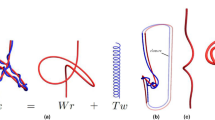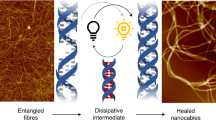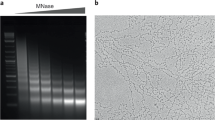Abstract
The synthetic polynucleotide poly[d(AT)]·poly[d(AT)] is of interest in studies of the relationship between nucleic acid structure and function. In particular, A+T-rich regions in DNA double helices have been invoked as centres for controlling the transcription of genetic information. Here we describe conditions for observing by X-ray fibre diffraction the A, B, C and D conformations of Na-poly[d(AT)]·poly[d(AT)], and for inducing transitions between these conformations. The D form emerges as a particularly stable conformation; once assumed, it persists over a wide range of variation in the relative humidity of the fibre environment. Further, while transitions between the B and D conformations are readily reversible, transitions between A and D are much more complex.
This is a preview of subscription content, access via your institution
Access options
Subscribe to this journal
Receive 51 print issues and online access
$199.00 per year
only $3.90 per issue
Buy this article
- Purchase on Springer Link
- Instant access to full article PDF
Prices may be subject to local taxes which are calculated during checkout
Similar content being viewed by others
References
Davies, D. R. & Baldwin, R. L. J. molec. Biol. 6, 251–255 (1963).
Fuller, W., Wilkins, M. H. F., Wilson, H. R. & Hamilton, L. D. J. molec. Biol. 12, 60–80 (1965).
Langridge, R. et al. J. molec. Biol. 2, 38–64 (1960).
Arnott, S. & Hukins, D. W. L. Biochem. biophys. Res. Commun. 47, 1504–1509 (1972).
Arnott, S. & Hukins, D. W. L. J. molec. Biol. 81, 93–105 (1973).
Marvin, D. A., Spencer, M., Wilkins, M. H. F. & Hamilton, L. D. J. molec. Biol. 3, 547–565 (1961).
Arnott, S., Chandrasekaran, R., Hukins, D. W. L., Smith, P. J. C. & Watts, L. J. molec. Biol. 88, 523–533 (1974).
Leslie, A. G. W., Arnott, S., Chandrasekaran, R. & Ratliff, R. L. J. molec. Biol. 143, 49–72 (1980).
Mitsui, Y. et al. Nature 228, 1166–1169 (1970).
Gupta, G., Bansal, M. & Sasisekharan, V. Int. J. biol. Macromolecules 2, 368–380 (1980).
Drew, H. R. & Dickerson, R. E. EMBO J. 1, 663–667 (1982).
Hoogsteen, K. Acta crystallogr. 12, 822–823 (1959).
Rhodes, N. J. et al. Nature 296, 267–269 (1982).
Cooper, P. J. & Hamilton, L. D. J. molec. Biol. 16, 562–563 (1966).
Arnott, S. & Selsing, E. J. molec. Biol. 88, 509–521 (1974).
Author information
Authors and Affiliations
Rights and permissions
About this article
Cite this article
Mahendrasingam, A., Rhodes, N., Goodwin, D. et al. Conformational transitions in oriented fibres of the synthetic polynucleotide poly[d(AT)]·poly[d(AT)] double helix. Nature 301, 535–537 (1983). https://doi.org/10.1038/301535a0
Received:
Accepted:
Issue Date:
DOI: https://doi.org/10.1038/301535a0
Comments
By submitting a comment you agree to abide by our Terms and Community Guidelines. If you find something abusive or that does not comply with our terms or guidelines please flag it as inappropriate.



